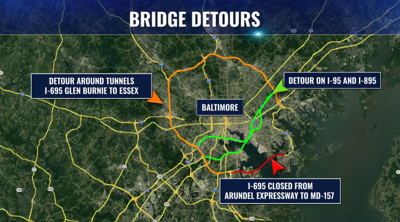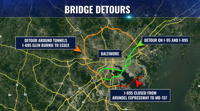BALTIMORE, Md. - Detours are in place after the Francis Scott Key Bridge collapsed early Tuesday morning, triggering a major traffic upheaval in southeastern Baltimore County.
According to the Maryland Department of Transportation, both outer and inner loops of I-695 have been shut down, with closures in place at MD 10 (Arundel Expressway) for the outer loop and MD 157 (Peninsula Expressway) for the inner loop. Additionally, the ramp from MD 157 to the inner loop of I-695 will be inaccessible.
The bridge collapsed around 1:30 a.m. after a container ship struck it.
Given the severity of the situation, commuters are urged to seek alternate routes and exercise patience as traffic volumes surge on surrounding roads. Drivers traversing north/south routes are advised to utilize I-95 and the Fort McHenry Tunnel or I-895 and the Baltimore Harbor Tunnel as viable alternatives.
However, it's crucial to note that commercial vehicles carrying certain hazardous materials, such as propane-laden recreation vehicles, are prohibited from these tunnel crossings. As a result, these vehicles must navigate through I-695 (Baltimore Beltway) between Essex and Glen Burnie, inevitably leading to significant delays.
For the most up-to-date information and guidance, motorists are encouraged to stay informed via official channels. The Maryland Transportation Authority is providing regular updates, accessible through its website.






